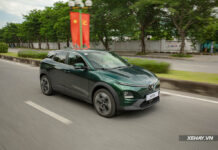Introduced to the Vietnamese market yesterday (October 25), the Honda CR-V 2024 is a hot name that has received a lot of attention. In addition to the surprisingly high price that has caused controversy, the attraction from the hybrid version cannot be denied as this is the first time the CR-V has a hybrid powertrain in Vietnam.

The Honda CR-V e:HEV 2024 (hybrid) is the only version imported completely from Thailand.
The Honda CR-V e:HEV 2024 is priced at 1,259 billion VND, significantly more expensive than its direct competitor in the segment which is the Haval H6 HEV (1,096 billion VND). Moreover, this price is even comparable to mid-size 7-seater SUVs, for example, the Ford Everest (1,099-1,499 billion VND).
With such disadvantages, why is Honda Vietnam still positioning the CR-V as a strategic product, even confident that the hybrid version will attract Vietnamese customers? Below are some of our quick impressions of this vehicle.
Exterior of the Honda CR-V e:HEV 2024
In the 6th generation, the Honda CR-V 2024 undergoes a complete transformation with a more square and muscular design compared to the previous generation. On the e:HEV version, the car is equipped with the RS package which includes many details painted black to enhance the sportiness compared to the standard version, such as alloy wheels, rearview mirrors… In addition, the logo on the front grille also has a blue accent to indicate that this is a hybrid version.

The Honda CR-V e:HEV 2024 is equipped with full LED lighting system. The front lights have automatic on/off and automatic light distribution adjustment functions.

The 18-inch alloy wheels have the same design as the standard version but are painted black. The difference is in the Dunlop Sport Maxx tires which are usually found on high-performance vehicles.

The electrically adjustable/folding rearview mirror is equipped with a 360-degree camera and a side camera that has lane watching function.

The overall dimensions of the car (L x W x H) are 4,691 x 1,866 x 1,681 mm.

At the rear, the car is equipped with a sporty dual exhaust system. The taillights still have an “L” shape like the old generation but the interior interface is more updated and complex.
Interior of the Honda CR-V e:HEV 2024
Stepping inside, the cabin of the new CR-V has a design reminiscent of the Honda Civic in the C segment. The overall interior is no different from the standard version except for the red stitching on a black background.

The wheelbase of the Honda CR-V e:HEV 2024 is 2,701 mm, the same as the Mazda CX-5. Unlike the standard versions, this variant is only available as a 5-seat configuration.

The dashboard has a honeycomb-shaped grille cover for the air conditioning vents, which is eye-catching but difficult to clean due to dust accumulation.

The steering wheel of the Honda CR-V e:HEV 2024 is wrapped in leather, fully integrated with volume control buttons, hands-free calling and menu function adjustments.

There are paddle shifters due to this version using an E-CVT transmission.

The instrument cluster behind the steering wheel is a 10.2-inch TFT display.

The floating 9-inch touchscreen comes with wireless Apple CarPlay/Android Auto connectivity.

Among the 4 versions of the Honda CR-V 2024, this is the only variant equipped with 12 Bose speakers.

The air conditioning system is a dual-zone automatic type with fast cooling feature Max Cool.

The gear lever has a basic design, and next to it is the electronic parking brake integrated with automatic hold function and mode change paddle shifters.

In the area in front of the gear lever, there is wireless phone charging, a 12V charging socket, a USB-A and Type-C connection port.

The front seats of the Honda CR-V e:HEV have thick cushions and a 2-wing design that hugs the back of the sitter.

The 8-way power-adjustable driver’s seat has 2 memory positions, while the passenger seat can only be adjusted electrically in 4 directions.

The rear air conditioning vents integrate 2 USB-C charging ports.

Since there is no third row, the second row seats of the Honda CR-V e:HEV 2024 have a spacious legroom, a relatively deep recline angle.

This version is equipped with a panoramic sunroof.
In addition to the above highlights, the Honda CR-V e:HEV 2024 also has other notable features such as: automatic anti-glare rearview mirror, remote trunk opening/closing and remote start functions.
Initial impressions of the performance of the Honda CR-V e:HEV 2024
In terms of specifications, the Honda CR-V e:HEV 2024 is equipped with a naturally aspirated 2.0L gasoline engine combined with 2 electric motors at the front axle, creating a total output of 204 horsepower and a maximum torque of 335 Nm.

According to the manufacturer’s announcement, the Honda CR-V e:HEV 2024 consumes only 3.4 liters per 100 km. The car does not have a pure electric mode (EV Mode).
Basically, the electric motor on the Honda CR-V e:HEV 2024 will operate instead of the gasoline engine at low speeds. When needed, the electric motor will also assist the gasoline engine, providing additional power for acceleration, and when the engine reaches the optimal speed range, the electric motor will shut off, and only the engine will operate.
In real-world driving with the CR-V e:HEV, the car has an interesting acceleration ability compared to the turbocharged 1.5L gasoline versions. Thanks to the assistance of the electric motor, the car accelerates smoothly in the speed range of 10 – 30 km/h with very little delay, more interesting than the pure gasoline version.

From the speed range of 30 – 80 km/h, the car has a good acceleration. After 80 km/h, engine noise is more noticeable in the cabin due to higher engine RPM.
The steering wheel of the CR-V has a moderate level of tightness and provides a genuine driving feel. The suspension system is a plus point as it allows for smooth cornering even at high speeds without feeling “floppy” or swaying sideways.
In Sport mode, the throttle response is more sensitive, making the CR-V e:HEV have a stronger corner-exiting ability than the standard version. In addition, the Dunlop Sport Maxx tires also provide good traction.
Safety features of the Honda CR-V e:HEV 2024
Similar to other versions, the Honda CR-V e:HEV 2024 is also equipped with the Honda Sensing safety technology package, but stands out with the intelligent adaptive headlight feature (ADB). The remaining features include: collision mitigation braking system (CMBS), adaptive cruise control including low-speed range, lane departure mitigation (RDM), lane keeping assist system (LKAS), automatic adaptive headlights (AHB), front departure alert (LCDN).

In addition to the Honda Sensing package, the Honda CR-V e:HEV 2024 is also equipped with other notable “options” such as a 360-degree camera, front/rear parking sensors, drowsiness warning, and tire pressure warning.
In real-world testing within the area organized by Honda Vietnam, the CR-V e:HEV 2024 leaves an impression when it comes to adaptive cruise control including the low-speed range. With speeds below 30 km/h, the car can easily recognize the car in front and follow at a passing speed. When the car in front brakes or turns, the CR-V’s brake system automatically adjusts gradually, without causing sudden jerks.
With the collision mitigation braking system, Honda technicians said the car could detect at speeds below 100 km/h. When a obstacle is detected in front, the car will beep 3 times; if the user does not actively brake, the system will intervene automatically.
However, the automatic braking distance is quite close to the vehicle in front and the braking force is quite strong, which can cause a sudden jerk if the driver is not focused.
Conclusion
Above are our quick experiences with the hybrid version of the Honda CR-V 2024 in limited time. In general, the hybrid system on this variant provides an interesting driving experience, easily satisfying those who enjoy the feeling of being behind the wheel.
The price of 1,259 billion VND for this variant is indeed not cheap, but it is expected to still attract a separate group of customers. Although it does not have a full-time 4-wheel drive system like the L variant, the front-wheel drive system still satisfies up to 90% of the daily driving needs of users.































![[CAR REVIEW] Honda City 2023: Easily Satisfying Consumers](https://vnauto.net/wp-content/uploads/2023/10/xehay-hondacity-26092023-1-150x150.jpg)
![[CAR REVIEW] Skoda Kodiaq set to debut in Vietnam: A “perfect” family car](https://vnauto.net/wp-content/uploads/2023/10/xehay-skodakodiaq-09092023-1-150x150.jpg)

![[USER REVIEW] Honda Civic RS: Stylish, Premium, and Alluring](https://vnauto.net/wp-content/uploads/2023/10/xehay-hondacivicrs-08042023-2-150x150.jpg)













